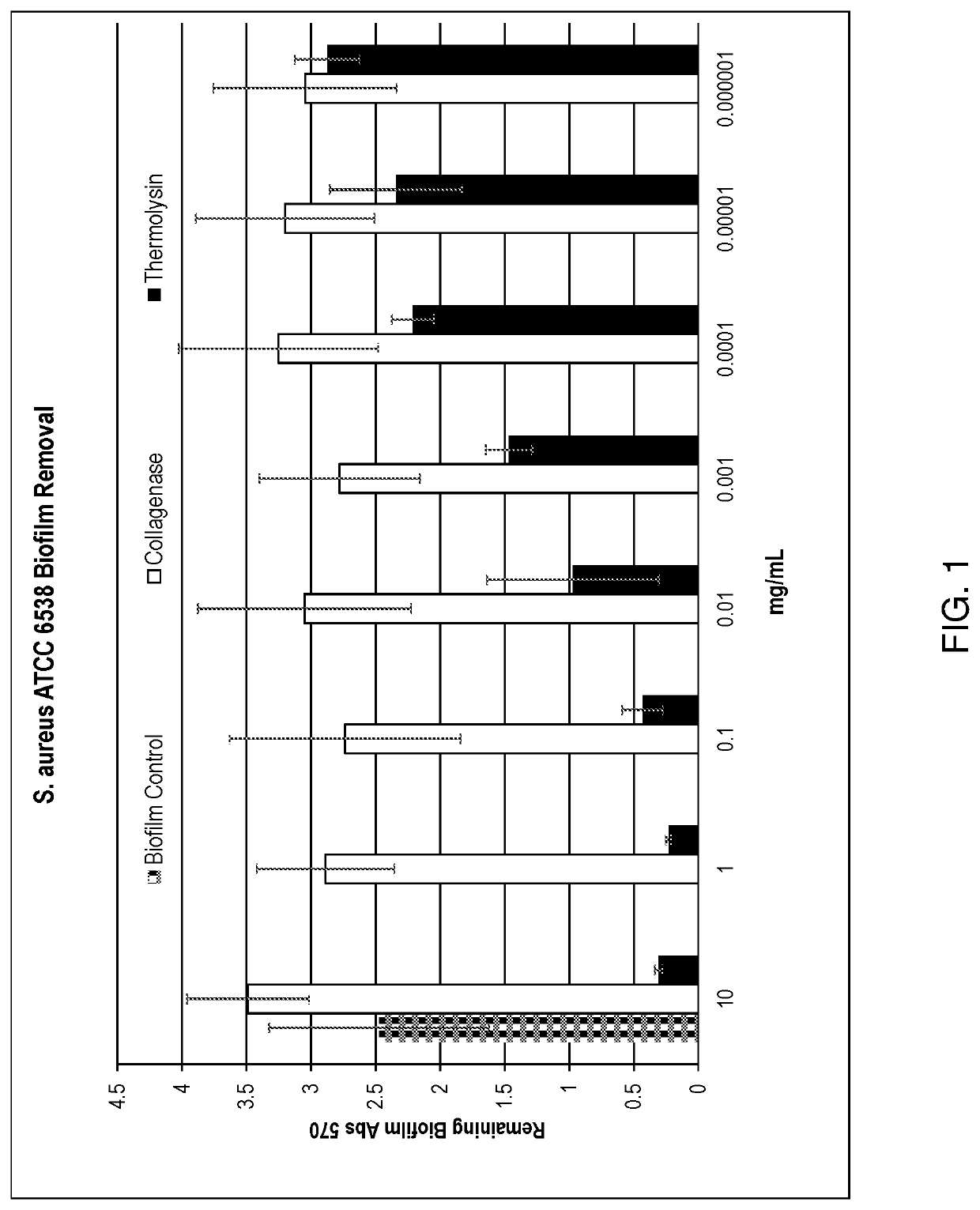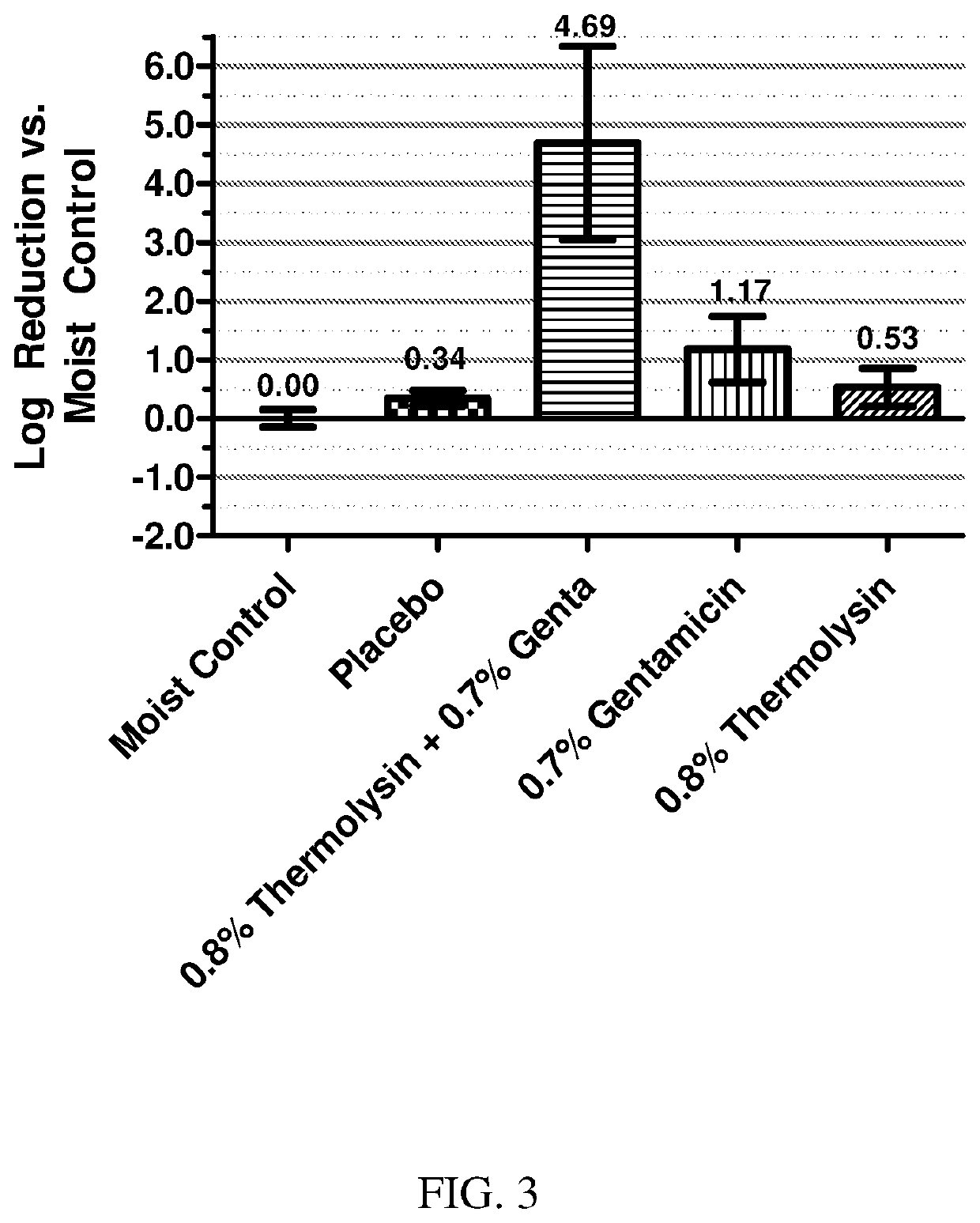Synergistic combination of thermolysin and an antibacterial agent to reduce or eliminate bacterial biofilms from surfaces
a technology of thermolysin and antibacterial agent, which is applied in the direction of antibacterial agents, prostheses, catheters, etc., can solve the problems of difficult to substantially reduce or eliminate, difficult for the antibacterial active to penetrate the biofilm network, and biofilms constitute a significant threat to human health, so as to reduce or eliminate bacterial biofilms, reduce bacteria in and/or eliminating bacterial biofilms, and reduce the effect of bacteria
- Summary
- Abstract
- Description
- Claims
- Application Information
AI Technical Summary
Benefits of technology
Problems solved by technology
Method used
Image
Examples
example 1
Gram-Positive Bacterial Biofilm Study with Thermolysin and Collagenase
[0235]An in-vitro assay was performed to determine the bacterial biofilm reduction capabilities of thermolysin and collagenase on gram-positive bacterial biofilms. In this assay, S. aureus ATCC 6538 was suspended in a growth media of tryptic soy broth supplemented with 0.25% glucose for optimal bacterial biofilm formation. The suspension was transferred to the wells of sterile 96 well plates and incubated for 22 hours at 37° C. with one change of media. After formation of the bacterial biofilm, the growth media was replaced with solutions of thermolysin dissolved in growth media at various concentrations in some wells and replaced with solutions of collagenase dissolved in growth media at the same concentrations in other wells (enzyme concentrations were 0.000001 mg / mL, 0.00001 mg / mL, 0.0001 mg / mL, 0.001 mg / mL, 0.01 mg / mL, 0.1 mg / mL, 1.0 mg / mL, and 10 mg / mL). After 16 hours, the remaining attached bacteria were qu...
example 2
Gram-Negative Bacterial Biofilm Study with Thermolysin and Collagenase
[0236]An in-vitro assay was performed to determine the bacterial biofilm reduction capabilities of thermolysin and collagenase on gram-negative bacterial biofilms. In this assay P. aeruginosa ATCC15442 was suspended in a growth media of 10% tryptic soy broth in PBS supplemented with 0.45% glucose (TSBG). The suspension was transferred to the wells of sterile 96 well plates and incubated for 18 hours at 37° C., then the media was changed with fresh media and incubated an additional 8 hours at 37° C. After formation of the bacterial biofilm, the growth media was replaced with solutions of thermolysin dissolved in TSBG growth media at various concentrations in some wells and replaced with solutions of collagenase dissolved in growth media at the same concentrations in other wells (enzyme concentrations were 0.00001 mg / mL, 0.0001 mg / mL, 0.001 mg / mL, 0.01 mg / mL, 0.1 mg / mL, 1.0 mg / mL, and 10 mg / mL). After 18 hours at 37...
example 3
s of Gentamicin Sulfate and Gentamicin Sulfate Plus Thermolysin for Gram-Positive and Gram-Negative Bacteria
[0237]The minimum inhibitory concentration (MIC) values of gentamicin sulfate and gentamicin sulfate plus thermolysin for S. aureus and P. aeruginosa suspensions were generated and are shown in Table 2. The concentration of thermolysin in the MIC experiments was kept constant at 50 μg / mL.
TABLE 2MIC valuesGentamicinGentamicinsulfate plussulfatethermolysin(μg / mL)(μg / mL)StrainRep 1Rep 2Rep 1Rep 2S. aureus ATCC 292131.61.61.61.6P. aeruginosa ATCC 2731250505050
[0238]As can be seen with the MIC values in Table 2, the addition of thermolysin to gentamicin sulfate did not affect the MIC of gentamicin sulfate for S. aureus or P. aeruginosa bacteria.
PUM
| Property | Measurement | Unit |
|---|---|---|
| concentrations | aaaaa | aaaaa |
| concentrations | aaaaa | aaaaa |
| concentrations | aaaaa | aaaaa |
Abstract
Description
Claims
Application Information
 Login to View More
Login to View More - R&D
- Intellectual Property
- Life Sciences
- Materials
- Tech Scout
- Unparalleled Data Quality
- Higher Quality Content
- 60% Fewer Hallucinations
Browse by: Latest US Patents, China's latest patents, Technical Efficacy Thesaurus, Application Domain, Technology Topic, Popular Technical Reports.
© 2025 PatSnap. All rights reserved.Legal|Privacy policy|Modern Slavery Act Transparency Statement|Sitemap|About US| Contact US: help@patsnap.com



